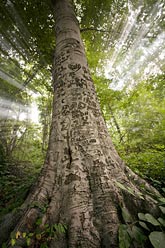
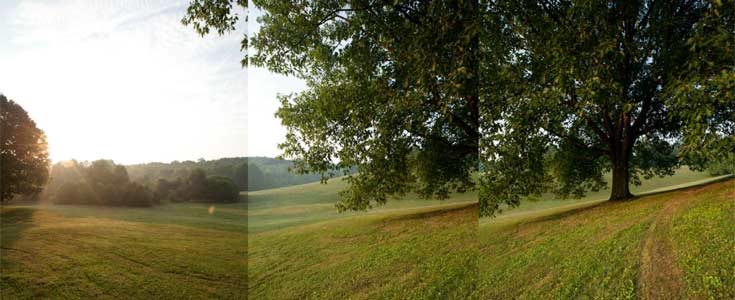
Photograph © Bob Hower
Louisville’s system of Olmsted parks and parkways consists of three flagship parks (Cherokee, Shawnee, and Iroquois) and the six parkways that connect them, all designed by landscape architect Frederick Law Olmsted, Sr. and his sons. For more than three decades, the Olmsted firm shaped the city—18 parks and 14.5 miles of boulevards in all, each designed in deference to the natural topography. Within these historic landscapes, the tree canopy created by over 6000 Olmsted-era heritage trees is at risk.
History
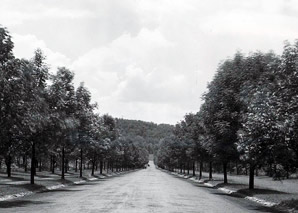
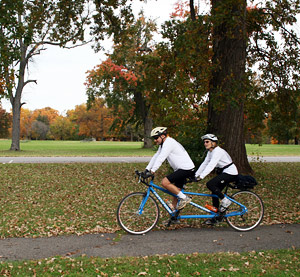
(top) Southern Parkway, 1920; (bottom) Shawnee Park, 2010.
Courtesy Olmsted Parks Conservancy
As a 19th century social democrat, Frederick Law Olmsted, Sr. was both visionary and practical in his attitude toward the design of public parklands. He believed that these landscapes, especially parks and other public projects, should enhance the quality and enjoyment of life for all members of the community, not just the most affluent. He also recognized the economic, social, and cultural benefits of city life and appreciated the humanizing qualities of the countryside. Thus, his park and boulevard designs attempted to combine the best aspects of urban and rural.
In 1891, Olmsted addressed the Salmagundi Club, a small group of Louisville civic leaders, to further their interest in establishing a park system. In response to the meeting, Olmsted developed a plan showing three large parks, one in each geographical sector of the city along with connecting boulevards. Each design honored the proposed park-site’s natural topographic attributes. Thus, in the east, Cherokee Park was characterized by rolling hills and a winding, shaded creek. To the south, Iroquois Park was formed as a sylvan forest, integrating native woodlands. In stark contrast, the design for Shawnee Park—with its flat, open space and lengthy shoreline on the Ohio River—featured wide-open meadows and took full advantage of the riverfront views and vistas. Olmsted's original ideals still can be found in these parks today.
After Olmsted, Sr.’s retirement, the Olmsted Brothers firm (with his sons John Charles Olmsted and Frederick Law Olmsted, Jr.) continued designing neighborhood parks, squares, and playgrounds throughout Louisville, for a total of 18 Olmsted-designed parks, including Seneca Park. Over a thirty year period, the firm also developed 14.5 miles of parkways (Northwestern, Southwestern, Algonquin, Southern, Eastern, and Cherokee which total) to unify the parks and open spaces with the city. Olmsted, Sr.’s vision for the parkways had focused on pleasure driving, bicycling, horseback riding, and leisurely strolls. He established a formal, linear quality for the parkways, with a central drive, offset rows of native hardwood trees, a pedestrian path and, in some cases a median. To implement this, the firm planted two rows of trees, 50 feet apart on both sides of the street on five of the parkways and three rows of trees, 50 feet apart on Southern Parkway.
For almost 100 years Louisville’s Olmsted parks remained virtually untouched. Then, several significant events occurred that changed the face of the system. In 1969, an interstate highway was carved into the Cherokee Park landscape: with it came pollution, noise, and invasive plants. In 1974, a series of Force 4 and 5 tornadoes ripped their way down several parkways and into Cherokee Park and Seneca Park (a later Olmsted firm project), taking down thousands of mature canopy trees, completely changing the park, its character and habitat, in a few minutes. Despite these and other challenges to the fabric of its Olmsted-era parks and parkways, the Louisville park system retained adequate integrity to be listed in the U. S. National Register of Historic Places in 1982. In 1989, the Louisville Olmsted Parks Conservancy formed as a non-profit partner of Louisville and Metro Parks to preserve and restore this civic legacy.
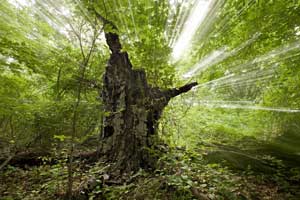
Extremely high winds caused extensive damage when Hurricane
Ike
passed through the city in September 2008.(top) Photograph
© Bob Hower; (bottom)
Courtesy Olmsted Parks Conservancy
Today, the Louisville Park System is valued nationally as the last large park system designed by the elder Olmsted. Along with the park system for Rochester, New York, it also was only system that was designed by all three Olmsteds (father, son, and stepson). In addition, over the past century, the city of Louisville itself literally developed around the three Olmsted-designed flagship parks: today, the parks are the central feature of some of the city’s most desirable neighborhoods. Currently, the city’s mature tree canopy includes over 6,000 trees planted during the Olmsted design era.
Threat
The latest major damage to the historic tree canopy occurred in 2008 when Hurricane Ike stormed through the city, felling enormous Olmsted-era trees. Close on the heels of the hurricane, a brutal ice storm entombed Louisville for a week. Virtually all the parks and parkways were affected with the loss of mature canopy “sentinel” trees. Several of the parkway allées now have significant gaps which reduce the integrity—and belie the significance—of the historic spatial organization of the sequence of central drive, tree rows, and related access drives.
